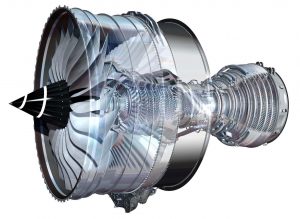
Rolls‑Royce has applied for a patent for a new material for use in higher-efficiency jet engines, after collaborating with University of Cambridge scientists to study new alloys using neutron beams.
Source: Canadian Neutron Beam Centre (CNBC)
Contact: cnbc@cnl.ca
Image: Takeoff of a test flight for Rolls-Royce’s latest and most energy-efficient jet engine, the Trent XWB. (Credit: Airbus)
Developing more energy-efficient transportation is a global priority—and one that was highlighted in Mission Innovation, a commitment made by more than 20 countries to double spending on clean energy research in order to meet the targets set out in the 2015 Paris Agreement on climate change.

Rolls Royce’s most efficient jet engine to date, the Trent XWB. Rolls Royce aims to reduce the fuel consumption and greenhouse gas emissions of its jet engines by an additional 10% within the next decade. (Image: Rolls Royce)
One area that has a lot of potential for energy savings is air travel. “Making jet engines one percent more efficient would translate into avoiding 500 to 1000 tonnes of carbon dioxide for each plane every year,” says Katerina Christofidou, a post-doctoral researcher at the Rolls‑Royce University Technology Centre at the University of Cambridge in the United Kingdom. “That’s like taking 100 to 200 cars off the roads for each plane with a better engine.”
Since 2000, Rolls‑Royce has improved the efficiency of its jet engines by over 10 percent. It aims to achieve a more than 20 percent improvement by 2025—a feat that would be well in line with the airline industry’s goal of becoming 30 percent more energy efficient by 2050.
One way to make a jet engine more efficient is to increase its operating temperature. The laws of thermodynamics tell us that the hotter the temperature of the air entering the jet engine’s turbine, the more efficient the engine can be. However, a lack of commercially viable materials that can withstand extreme heat over time is a main barrier that hinders the industry from achieving higher operating temperatures.
In addition to increasing engine efficiency, the availability of such materials would help airlines to better meet the operational demands of the air travel industry. That’s because busy airports encourage departing flights to climb rapidly to cruising altitude in order to clear the way for other flights. And the faster an aircraft can reach cruising altitude, the less fuel it will use overall. However, such sharp climbs require the engines to operate at maximum temperatures for longer periods, which can limit the lifespan of certain engine components (e.g., the rotor discs, which hold the turbine blades).
The new material will provide a better balance of necessary properties up to 800 °C, including mechanical strength and resistance to crack growth, deformation, and environmental damage.
Thus, the airline industry has both environmental and operational incentives to invest in research to develop new materials that can better withstand higher temperatures. Such an advancement would be no small feat, as the operating temperatures in today’s jet engine turbines already reach as high as 1300 °C. Even the air that surrounds the rotor discs and cools the turbine blades is often between 650 °C and 700 °C. To raise the engine’s operating temperature higher in the future, the industry anticipates a need for rotor discs made of advanced materials that can withstand even higher temperatures (i.e., when the cooling air is between 700 °C and 800 °C) for long periods of time.
Rolls‑Royce recently turned to Christofidou and her doctoral supervisor, Prof. Howard Stone of the University of Cambridge, for help in developing a material with the requisite properties. In the resulting research, which was co‑funded and co‑supervised by Rolls‑Royce, Christofidou explored how incremental changes in the chemical compositions of the nickel-based alloys used in rotor discs today could raise the components’ safe operating temperature.
One of her studies used several experimental techniques to examine nickel-based alloys with 27 chemical variations in order to identify the most promising candidates. She found that the microscopic structures of these alloy samples consisted of two distinct ‘phases’ (i.e., portions of a material in which all physical properties are identical because both the chemical composition and the three-dimensional spatial pattern of the atoms remain consistent throughout).

Illustration of cube-like spatial patterns in two separate phases (not to scale). Actual patterns vary for each alloy. Image: Katerina Christofidou.
The two phases in Christofidou’s alloys had different chemical compositions yet nearly identical spatial patterns, one of which was a slightly shrunken version of the other pattern. Because only neutron beams could measure this size difference, she accessed the Canadian Neutron Beam Centre (CNBC) in 2014 and 2015 to determine the exact size variance between the two phases’ spatial patterns for each alloy. The findings, published in 2016, showed that the alloys with the greatest difference in pattern size were also the strongest. These results provided important insights into how chemical composition affects the desired properties of nickel-based alloys.
Prof. Stone’s research team has since input the data into predictive computer models to identify other incremental changes that might lead to further improvements. Notably, this data has informed Rolls‑Royce’s recent decision to make, study, and apply to patent a new material. Rolls-Royce reports that this new material should provide a better balance of properties (e.g., mechanical strength and resistance to crack growth, deformation, and environmental damage) at elevated service temperatures (i.e., up to 800 °C) as compared to existing alloys.
Today, Christofidou is continuing her research on nickel-based alloys and is now fully funded by Rolls-Royce. She plans to return to the CNBC to examine more sample alloys under realistic operating temperatures in order to obtain some additional insights needed to fine-tune their performance.
